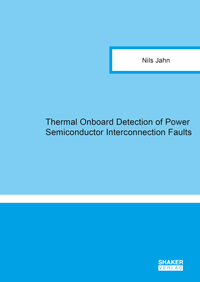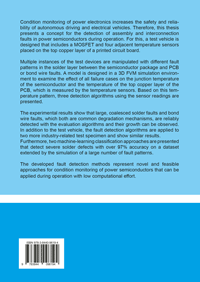
Shop : Details
Shop
Details
58,80 €ISBN 978-3-8440-9619-4Softcover162 pages97 figures219 g21 x 14,8 cmEnglishThesis
September 2024
Nils Jahn
Thermal Onboard Detection of Power Semiconductor Interconnection Faults
Condition monitoring of power electronics increases the safety and reliability of autonomous driving and electrical vehicles. Therefore, this thesis presents a concept for the detection of assembly and interconnection faults in power semiconductors during operation. For this, a test vehicle is designed that includes a MOSFET and four adjacent temperature sensors placed on the top copper layer of a printed circuit board.
Multiple instances of the test devices are manipulated with different fault patterns in the solder layer between the semiconductor package and PCB or bond wire faults. A model is designed in a 3D FVM simulation environment to examine the effect of all failure cases on the junction temperature of the semiconductor and the temperature of the top copper layer of the PCB, which is measured by the temperature sensors. Based on this temperature pattern, three detection algorithms using the sensor readings are presented.
The experimental results show that large, coalesced solder faults and bond wire faults, which both are common degradation mechanisms, are reliably detected with the evaluation algorithms and their growth can be observed. In addition to the test vehicle, the fault detection algorithms are applied to two more industryrelated test specimen and show similar results. Furthermore, two machine-learning classification approaches are presented that detect severe solder defects with over 97 % accuracy on a dataset extended by the simulation of a large number of fault patterns.
The developed fault detection methods represent novel and feasible approaches for condition monitoring of power semiconductors that can be applied during operation with low computational effort.
Multiple instances of the test devices are manipulated with different fault patterns in the solder layer between the semiconductor package and PCB or bond wire faults. A model is designed in a 3D FVM simulation environment to examine the effect of all failure cases on the junction temperature of the semiconductor and the temperature of the top copper layer of the PCB, which is measured by the temperature sensors. Based on this temperature pattern, three detection algorithms using the sensor readings are presented.
The experimental results show that large, coalesced solder faults and bond wire faults, which both are common degradation mechanisms, are reliably detected with the evaluation algorithms and their growth can be observed. In addition to the test vehicle, the fault detection algorithms are applied to two more industryrelated test specimen and show similar results. Furthermore, two machine-learning classification approaches are presented that detect severe solder defects with over 97 % accuracy on a dataset extended by the simulation of a large number of fault patterns.
The developed fault detection methods represent novel and feasible approaches for condition monitoring of power semiconductors that can be applied during operation with low computational effort.
Keywords: Power Electronics; Condition Monitoring; Elektrotechnilk
Available online documents for this title
DOI 10.2370/9783844096194
You need Adobe Reader, to view these files. Here you will find a little help and information for downloading the PDF files.
Please note that the online documents cannot be printed or edited.
Please also see further information at: Help and Information.
Please also see further information at: Help and Information.
| Document |  | Abstract | ||
| Type |  | |||
| Costs |  | free | ||
| Action |  | Download the file | ||
| Document |  | Document | ||
| Type |  | |||
| Costs |  | 44,10 € | ||
| Action |  | Purchase in obligation and download the file | ||
| Document |  | Table of contents | ||
| Type |  | |||
| Costs |  | free | ||
| Action |  | Download the file | ||
User settings for registered online customers (online documents)
You can change your address details here and access documents you have already ordered.
User
Not logged in
Export of bibliographic data
Shaker Verlag GmbH
Am Langen Graben 15a
52353 Düren
Germany
Am Langen Graben 15a
52353 Düren
Germany
Mon. - Thurs. 8:00 a.m. to 4:00 p.m.
Fri. 8:00 a.m. to 3:00 p.m.
Fri. 8:00 a.m. to 3:00 p.m.
Contact us. We will be happy to help you.



